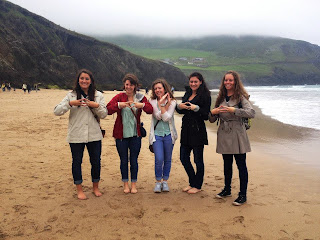We loaded the bus at 11.30 on Friday morning and took off towards the Dingle.
 |
| Bunratty Castle |
First we made a pit stop at the Bunratty Castle in Co. Clare for lunch and a little sight seeing. After the climb up the spiral staircases the view from the top was WELL worth all the dizziness and smells.
 |
| View from the top-front |
 |
| View the top-back |
 |
| Family picture at the castle in the head chairs |
There is no other landscape in western Europe with the density and variety of archaeological monuments as the Dingle Peninsula. This mountainous finger of land which juts into the Atlantic Ocean has supported various tribes and populations for almost 6,000 years. Because of the peninsula's remote location, and lack of specialised agriculture, there is a remarkable preservation of over 2,000 monuments.
It is impossible to visit the Dingle Peninsula and not be impressed by its archaeological heritage. When one combines each site's folklore and mythology, which have been passed orally from generation to generation through the Irish language, one can begin to understand how unique and complex is the history of this peninsula.
http://www.dingle-peninsula.ie/history.html
Rather than make this a lecture or lesson feel free to use this link to read more about the history of the Dingle:)
 |
We all lived in one room.
My guess is 24'x24', 6 bunks, 1 bathroom, 2 nights.
BONDING TIME.
Rm 29 will live in infamy. |
 |
| The view from our room! |
 |
| Salmon pasta = delicious |
On Saturday we loaded the bus to drive around the Dingle Pennisula and see all the historic "Bee Hive" houses, preserved churches
 |
"The laziest sheep in the world. Remington O'Hare."
Most would run away or charge at you! Yikes. |
 |
The view from the bus notice that little road,
slightly terrifying. |
 |
| Mixin' a little greek in our matching outfits! |
| Beehive huts or Clocháns are dry-stone buildings dating from c.2000 BC. They are usually round in shape, but rectangular huts are known as well. What gives these huts their distinctive appearance is a building technique known as corbelling, i.e. the layering of stones, with each layer bending slightly closer and narrower towards the peak. Stones were laid with an outward and downward tilt to shed water, making these huts watertight. |
Right across the street from the "Bee Hives" was this lovely view. Behind that far rock wall is a LARGE drop off into the water. One foul slip of a sheep herder or sheep and you're done. What was also incredible is that every rock wall is literally just stacked rocks. Imagine the patience and time. Goodness.
 |
| Just the view over the edge .... backin' up |
 |
| Arrived at the Dingle Peninsula |
 |
| speechless |
 |
The whole group! Too bad Courtney and I were a little behind ...
Love these kids :) |
 |
| ISA Greeks :) |
 |
| just a bunch of kids climbing on rocks |
 |
| Joe, Tom, Elissa, myself, Courtney, Rachel, Sarah, & Andrew |
 |
| "breakfast club" of Dingle :) |
 |
| one step and it's bye-bye |
While we physically left Dingle - a part of ISA will forever be there :)









No comments:
Post a Comment